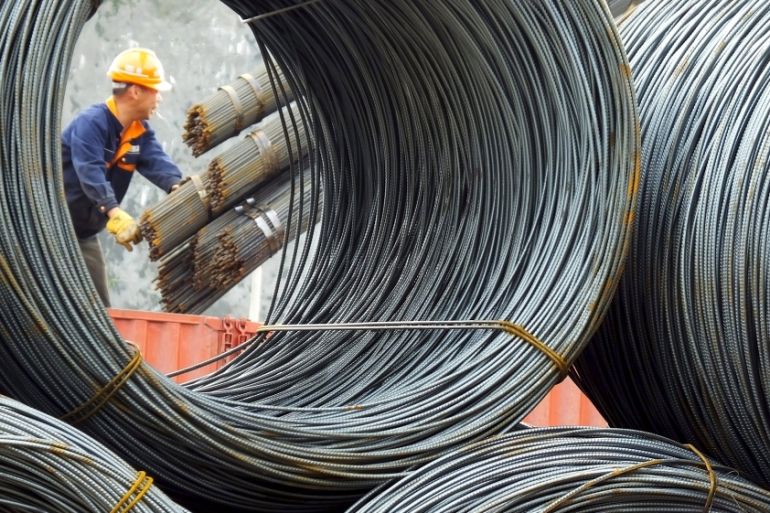China’s Dongbei model goes national
The privatisation of China’s SOEs is about much more than just reducing capacity in coal and steel.

Pittsburgh, Cleveland, Buffalo, Detroit: They’re all great American cities. But they have all seen better days. There are endless debates over what turned the United States’ industrial heartland into a post-industrial rust belt, but most people agree that some kind of transition was inevitable. The US simply doesn’t need hundreds of millions of tonnes a year of cheap steel any more.
Neither does China.
Keep reading
list of 4 itemsChina’s economy beats expectations, growing 5.3 percent in first quarter
Inside the pressures facing Quebec’s billion-dollar maple syrup industry
Manipur’s BJP CM inflamed conflict: Assam Rifles report on India violence
China is the Saudi Arabia of steel, and then some. China produces half the world’s steel, up from a third only 10 years ago. China’s steel output is nearly eight times that of Japan, its nearest competitor.
But China’s steel industry is highly fragmented. Its largest producer, Hebei Iron and Steel, accounts for about 6 percent of the country’s output. Compare that with Japan, where the largest steel producer, Nippon Steel, accounts for more than 40 percent.
China is chock-full of small, inefficient steel companies. The problem is that they are only “small” by Chinese standards.
Nearly two million people work for China’s state-owned steelmakers, not counting all the other jobs that directly or indirectly depend on steel.
The government plans to fire half a million of them, plus another 1.3 million coal miners. Layoffs in other industries are anticipated as well as government moves to privatise thousands of inefficient state-owned enterprises (SOEs).
The government-sponsored consolidation of China’s steel industry has hit hardest in heavily industrialised Hebei province, which surrounds Beijing. The proximity of Hebei to the capital has given foreign journalists easy access to its sights and stories of post-industrial apocalypse.
Industrial downsizing really began to bite in Hebei province in 2015. But it didn’t start there.
The Dongbei model
The Chinese government’s programme of privatisations accompanied by mass layoffs began a decade ago in northeast China’s little-visited Dongbei region.
The Dongbei – literally “Eastnorth” – was post-war China’s manufacturing heartland. It consists of the three provinces to the north and east of Beijing and Hebei.
Historically known as Manchuria, the region was occupied by Japan from 1931 to 1945. Many of its industries date to this era and were redeveloped with Soviet help in the 1950s.
Now that stability - if not necessarily economic growth - has returned, China seems ready to roll it out to the rest of the country in 2016. Privatisations are at the top of the agenda.
The three provinces of the Dongbei – Liaoning, Jilin, and Heilongjiang – were once major consumers of the steel produced just to the south in Hebei province.
Liaoning has been a centre of electrical equipment manufacturing since the Japanese occupation.
Communist China’s first indigenous car manufacturer, First Auto Works, was set up with Soviet help in Jilin’s provincial capital Changchun in 1953.
Heilongjiang sits atop the Daqing oilfield – China’s largest – and is the home of many petrochemical plants.
All these heavy industries used to be state-owned. No more. Most of the Dongbei’s large SOEs were privatised between 1997 and 2005.
They weren’t so much sold off to private investors as simply given away. Perceived as hopelessly inefficient, many were sold for the nominal price of one yuan.
OPINION: The rise of ‘everyday freedoms’ in China
The Dongbei privatisation wave began in Liaoning after a 1997 visit from former premier Zhu Rongji. A bastion of state ownership, Liaoning’s capital city Shenyang became famous as the birthplace of thousands of red capitalists – former government officials turned factory owners.
Most of Heilongjian’s leading SOEs were sold to private investors in 2004. Then in 2005 the Chinese government sold off 816 SOEs in Jilin province in just one year.
China has experienced many waves of SOE reform since its 1978 opening to the world, but the Dongbei wave is the one that most resembles the 1990s sell-offs in Eastern Europe and the former Soviet Union, when communist bureaucrats became billionaire oligarchs overnight.
Rolling out reforms
The national rollout of the Dongbei model of SOE reform was put on hold amid worries of industrial collapse when the 2008 global financial crisis hit China.
Now that stability – if not necessarily economic growth – has returned, China seems ready to roll it out to the rest of the country in 2016. Privatisations are at the top of the agenda.
Though ordinary workers may have much to lose from SOE reform, top managers in places such as Guangzhou and Shanghai are chomping at the bit for the opportunity to take over their companies.
In Hebei and the Dongbei provinces, SOE reform has been all about cutting losses. In central and southern China, it’s all about capturing gains.

China’s profitable non-financial SOEs are reputed to be sitting on massive piles of undistributed profits. Considering that these firms are government-owned and government-controlled, they have been remarkably dividend-averse. Though the central government has demanded higher dividend pay-outs in recent years, these have not necessarily been forthcoming.
The privatisation of China’s SOEs is about much more than just reducing capacity in coal and steel. As China makes the transition from rapid growth to a “new normal”, easy profits are becoming harder to find.
Privatisations offer a secure way to make big money in a slowing economy. Well-connected managers who are also high party members will reap the benefits. And it will be the ordinary workers who will pay the price.
Salvatore Babones is a comparative sociologist at the University of Sydney. He is a specialist in global economic structure.
The views expressed in this article are the author’s own and do not necessarily reflect Al Jazeera’s editorial policy.
